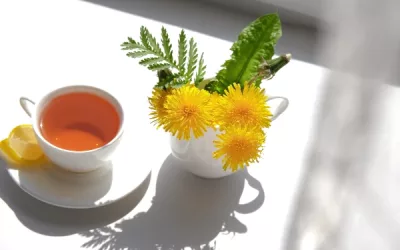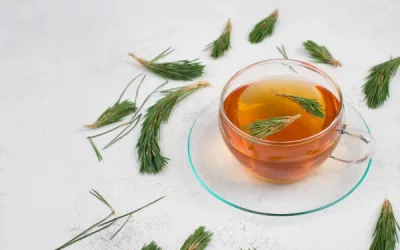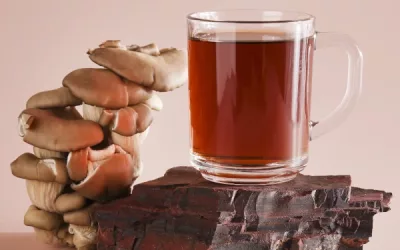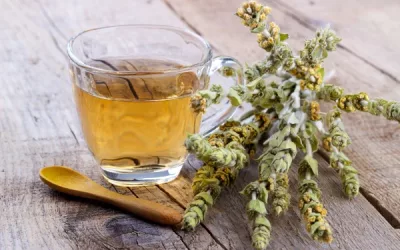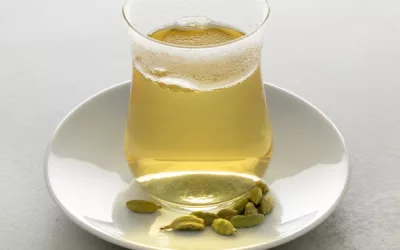Have you ever wondered why lavender has been cherished for centuries? Beyond its enchanting scent, lavender tea offers a treasure trove of health benefits, making it a go-to choice for wellness enthusiasts today. This guide delves into the calming effects of lavender tea, particularly for anxiety, sleep improvement, and menstrual discomfort. We’ll explore its benefits, preparation methods, and safety considerations, helping you discover how to integrate this soothing brew into your daily routine. Get ready to unlock the potential of lavender tea for your well-being!
Table of Content
What is Lavender tea?
Lavender tea is a herbal infusion made from the dried buds of the lavender plant (Lavandula angustifolia). It has a light, floral aroma and a slightly sweet taste with hints of mint and rosemary. Lavender tea is popular for its calming and soothing properties, often consumed to help with relaxation, stress relief, and improving sleep quality.
Lavender has been used for centuries in aromatherapy and herbal medicine due to its potential benefits. In tea form, it is typically prepared by steeping the dried lavender buds in hot water for about 5-10 minutes, allowing the oils and flavors to infuse into the water.
People enjoy lavender tea not only for its pleasant taste but also for its potential health benefits, which may include:
- Relaxation and Stress Relief: The calming effects of lavender tea are often used to help alleviate anxiety and promote relaxation.
- Improved Sleep: Lavender is commonly associated with sleep aid, and drinking lavender tea before bed may help improve sleep quality.
- Digestive Health: Some believe lavender tea can soothe digestive issues like indigestion and bloating.
- Pain Relief: Lavender has mild analgesic properties that may help reduce headaches and other minor pains.
However, it’s worth noting that while lavender tea is generally safe for most people, excessive consumption or use during pregnancy may not be advisable without consulting a healthcare provider.
What should I look for when buying lavender tea?
Selecting high-quality lavender tea isn’t rocket science, but it does require a bit of know-how.
- Ingredient List: The fewer ingredients, the better. Aim for 100% lavender buds or leaves.
- Aroma: It should have a strong, pleasant lavender smell, not a faint or musty odour.
- Colour: High-quality lavender will often have a vibrant purple hue.
- Packaging: Opt for teas in airtight containers to preserve freshness and potency.
- Expiry Date: Always check the expiry date to ensure you’re not buying stale tea.
So, when you’re standing in the tea aisle or scrolling online, make sure you scrutinise these factors closely. The next time you brew, you’ll taste the difference.
How can I ensure I’m buying organic lavender tea?
Ensuring your lavender tea is genuinely organic involves a bit of detective work.
- Certification Labels: Look for USDA Organic, Soil Association, or other recognised organic certifications.
- Brand Reputation: Stick to brands known for their commitment to organic products, like Traditional Medicinals or Yogi Tea.
- Price Point: Organic teas often cost a tad more. If it’s too cheap, be suspicious.
- Retailer Credibility: Buy from reputable stores or online platforms that specialise in organic products.
- Product Description: Pay close attention to labels and product descriptions that specify the tea is organic.
With these tips in your arsenal, you can sip easy knowing your lavender tea is free from unwanted chemicals.
Centuries before your local health store or online retailer existed, there was Catherine de Medici, Queen of France in the 16th century. Known for her vast knowledge of herbs and aromatics, she was a lavender enthusiast.
She used it in her perfumes and as a remedy to calm nerves. Her interest in herbal remedies helped elevate lavender’s status within royal circles and among Europe’s nobility. It’s thanks to historical influencers like her that we continue to enjoy the benefits of lavender tea today.
Now, go forth and conquer that lavender tea aisle with confidence!

How do you prepare lavender tea?
Preparing lavender tea is simple and enjoyable. This fragrant drink not only tastes great but also brings a sense of calm and well-being. To make the perfect cup of lavender tea, you need to consider the types of lavender, whether to use fresh or dried buds, and the ideal steeping time.
Choosing the right lavender is crucial for the best taste. English lavender, French lavender, and Lavandin are some of the varieties you can use. Fresh buds provide a delicate taste, while dried buds offer a more concentrated flavour. The steeping time can vary, but usually, 5-10 minutes is a good range.
Lavender types, flavour profiles, and best uses
Here’s a table to help you choose the right lavender for your tea:
| Lavender Type | Flavour Profile | Best Use |
|---|---|---|
| English Lavender | Sweet, floral, slightly fruity | Relaxation tea |
| French Lavender | Mild, sweet, slightly spicy | Evening tea |
| Lavandin | Strong, camphor-like, herbal | Energising tea |
| Spanish Lavender | Pine-like, slightly bitter | Culinary tea |
| Munstead Lavender | Sweet, aromatic | Everyday tea |
| Hidcote Lavender | Deep, sweet, earthy | Rich tea blends |
| Grosso Lavender | Strong, robust, slightly spicy | Bold tea blends |
This table helps you decide which type of lavender suits your taste and needs. For instance, if you want a relaxing evening tea, English lavender is a great choice. For a stronger, more energising tea, Lavandin would be better.
Steps to prepare lavender tea
Making lavender tea is straightforward. Here’s a simple guide:
- Pick your lavender: Choose between fresh or dried buds. Dried buds offer a stronger taste.
- Measure the lavender: Use about one teaspoon of dried buds or two teaspoons of fresh buds per cup.
- Boil water: Bring water to a boil, then let it cool slightly to around 90°C.
- Steep the lavender: Place the lavender in a tea infuser or directly in the cup, pour the water over it, and let it steep for 5-10 minutes.
- Strain and enjoy: If you used loose buds, strain the tea before drinking. Sweeten with honey if desired.
Types of lavender suitable for tea
Different lavender types can create unique tea experiences. Here’s a breakdown:
- English Lavender: Known for its sweet, floral flavour, perfect for a relaxing tea.
- French Lavender: Offers a mild and slightly spicy taste, ideal for an evening drink.
- Lavandin: A hybrid variety with a strong, herbal flavour, suitable for a morning boost.
- Spanish Lavender: Its pine-like and slightly bitter taste makes it excellent for culinary uses.
- Munstead Lavender: Sweet and aromatic, making it great for daily tea.
- Hidcote Lavender: Deep and earthy, perfect for rich tea blends.
- Grosso Lavender: Strong and robust, ideal for bold tea lovers.
Every lavender type can enhance your tea experience. Whether you want a soothing cup before bed or a strong, energising brew in the morning, there’s a lavender for that.
In the late 1800s, Queen Victoria was a huge fan of lavender. She often drank lavender tea to soothe her nerves and help with her migraines. It was common in the Victorian era to use lavender for its calming properties. Herbalists of that time valued lavender highly, not just for tea but also in tonics and balms. This historical use underlines just how long people have turned to lavender for wellness and comfort.
I remember when I first tried making lavender tea. I was sceptical about its soothing effects. I used English lavender, as recommended by a friend. The first sip was like a gentle sigh after a long day.
The sweet, floral notes were calming, and after a few minutes, I felt noticeably more relaxed. Now, whenever I feel stressed, I reach for my lavender buds. It’s a small ritual that brings a lot of peace to my life.
What are the cultural and historical uses of lavender?
Lavender isn’t just the sweet-smelling purple plant you see in grandma’s garden. It’s more like the one-herb-wonder for an array of historical and cultural uses that would blow your socks off. This unassuming flower has enchanted civilizations for centuries, from ancient Egypt’s embalming rituals to Victorian England’s medicine cabinets. Here, we’ll dive into the multifaceted saga of lavender in herbal medicine, culinary practices, folklore, and its ascendancy in modern wellness practices.
How has lavender been used in different cultures?
Buckle up because lavender has an impressive passport. Every culture it touched has had its unique relationship with this fragrant flora.
- Ancient Egypt: Pharaohs weren’t messing around; they included it in their mummification process, believing its divine scent would help them meet the gods.
- Ancient Greece and Rome: These folks knew how to relax. Lavender baths to cleanse the body and mind were all the rage among elites.
- Medieval Europe: Knights may need armour on the battlefield, but it turns out they needed lavender tonics to combat the stress of, well, not dying.
- Native American Tribes: Various tribes used lavender for pain relief and spiritual cleansing rituals.
- Asia: Whether it’s in Japan’s incense or India’s Ayurvedic medications, lavender has woven itself into the fabric of Asian cultures too.
That list could go on, but who’s got the time?
What are some historical remedies involving lavender?
Okay, grab your herbal medicine kit and let’s get medieval on this.
- Lavender Oil for Burns: Remember the burnt knight from earlier? He might’ve used lavender-infused oils for his burns and abrasions to speed up healing.
- Lavender Tea for Digestive Health: English physicians recommended sipping on this fragrant brew to soothe stomach ailments. Yes, even digestive dramas have historical precedents.
- Lavender Sachets for Insomnia: Ever wondered how people in the past dealt with insomnia? They filled their pillows with dried lavender, turning their dreams purple.
- Anti-Plague Lavender Bundles: During the times you don’t really want to imagine, lavender bundles were carried around as plague repellents. They might not have beaten the disease, but folks sure smelled good.
The key here? Lavender was the Swiss Army Knife of medicine, albeit one that smells ten times better.
How did lavender become popular in modern wellness?
Here’s where things get interesting. Lavender’s transformation from a medieval miracle worker to a modern-day wellness hero is quite the tale.
- Aromatherapy: Today, essential oils are all the rage. One whiff and that lavender goodness allegedly eases anxiety, promotes sleep, and improves your mood.
- Spa Treatments: Ever noticed the abundance of lavender in spa menus? From massages to facials, it’s become a go-to for relaxation.
- Cosmetics and Skincare: Lavender has wove its purple magic into the beauty industry for its soothing and antiseptic properties.
- Modern Medicine: Multiple studies suggest lavender’s effectiveness in reducing anxiety and treating insomnia. It’s not just folklore; science is in on it too.
- Edible Delights: Forget cucumbers; it’s all about lavender-infused teas, biscuits, and artisanal honey now.
Lavender’s clever rebranding is its unbeaten charm, elevating its status from an old-school remedy to a holistic lifestyle essential.
The essential oil trend exploded when a French chemist, René-Maurice Gattefossé, stumbled upon the wonders of lavender. In 1910, after burning his hand in a lab accident, he dunked it in lavender oil, and voilà – healing power discovered! This event not only saved his hand but also propelled the study of essential oils into mainstream wellness, crowning lavender as its unofficial queen. If that’s not a fascinating journey from the fields to wellness retreats, what is?
So next time you’re sipping lavender tea, spritzing lavender mist, or just ogling a lavender field on Instagram, remember – you’re part of an ancient, aromatic history.
Is lavender tea safe to drink daily?
Alright, let’s dive straight in, shall we? You’re probably wondering if guzzling down lavender tea every day is going to make you feel like a zen master or if it comes with a catch. Spoiler alert: there’s a bit of both involved.
Lavender tea is generally considered safe for most people when consumed in moderate amounts. However, the phrase “too much of a good thing” exists for a reason. This fragrant beverage, often touted for its calming properties, can have some side effects.
Plus, it’s not everyone’s cup of tea—pun absolutely intended. So, let’s break it down.
What are the side effects of drinking lavender tea regularly?
Let’s be real, even the most natural, flower-power things come with their quirks. Lavender tea can indeed have side effects if consumed daily.
- Digestive Issues: Think bloating, gas, and possibly even cramps. Your gut might have its reservations.
- Allergic Reactions: From mild to wild, itching to hives, if you’re allergic, this tea can cause chaos.
- Nausea: Sometimes, your stomach just doesn’t want to play nice.
- Headaches: Ironically, in some rare cases, it might bring the very tension it promises to sweep away.
Drinking lavender tea daily might seem like a good idea for stress, sleep, and those pesky period pains, but remember, everyone’s body’s unique and may react differently.
Are there any medication interactions with lavender tea?
Like that nosy neighbour, lavender tea doesn’t always mind its own business. It can interact with some medications.
- Sedatives: Lavender tea might double-team with sedatives, making you feel overly drowsy.
- Blood Pressure Meds: Since lavender has hypotensive properties, mixing it with blood pressure meds can make you feel like you’ve taken a one-way trip to La-La Land.
- Cholesterol-Lowering Drugs: Also known as statins, these might not play well with lavender.
- Antidepressants: Combining lavender tea with these can sometimes amplify the effects and leave you feeling a tad too tranquil.
So, before you start your daily lavender ritual, do a quick check with your doc or pharmacist to make sure they won’t clash with your prescriptions.
Who should avoid drinking lavender tea?
Just because something’s natural doesn’t mean it’s for everyone. Some people should give lavender tea a pass or at least proceed with caution.
- Pregnant Women: You’ve got enough on your plate without lavender potentially throwing a spanner in the works.
- Breastfeeding Mothers: It’s best to be cautious as little is known about its effects on your little one.
- Young Children: Their tiny bodies are still figuring things out; adding lavender tea into the mix might be too much.
- Those with Allergies: If you get sneezy around lavender plants, the tea might not be your friend either.
- People with Hormone-Sensitive Conditions: Conditions like breast cancer or uterine fibroids may interact negatively with lavender, which can mimic oestrogen.
So, who needs to back away from the lavender teapot? Pregnant or breastfeeding women, small children, those with certain allergies or hormone-sensitive conditions—are you in that camp?
Believe it or not, Queen Victoria was said to use lavender in her tea to relieve her headaches and calm her nerves. Back in those regal days, lavender was a hot commodity in royal health circles.
So, while this blend indeed has a flair for fancy, it’s always best consumed with a bit of caution and common sense. And let’s be honest, if it was good enough for Queen Vic… but remember, you aren’t royalty (probably) and your mileage may vary!
What are the health benefits of lavender tea?
Lavender tea has been cherished for centuries, not only for its delightful floral aroma but also for its extensive health benefits. I’ve found it to be quite a versatile herbal tea, capable of addressing a variety of health concerns. From improving mood to aiding sleep, this tea is a natural remedy that you might want to keep handy.
This calming beverage contains compounds like linalool and linalyl acetate, which contribute to its soothing effects. Lavender tea helps in managing mood disorders, enhancing sleep quality, reducing menstrual discomfort, improving skin health, and providing general relaxation. Let’s dive deeper into these benefits.
How does lavender tea affect mood disorders?
Lavender tea is known for its mood-enhancing properties. You might find it particularly useful if you experience anxiety or depression.
- The essential oils in lavender can help balance neurotransmitters like serotonin.
- It reduces symptoms of anxiety by affecting the limbic system, the part of your brain responsible for emotions.
- Drinking lavender tea can help you feel more relaxed, promoting a sense of calm.
- It may also help in reducing symptoms of mild depression.
- Regular consumption can lead to a more balanced mood over time.
By including lavender tea in your daily routine, you can potentially manage your mood disorders better. This might be especially beneficial if you’re seeking a natural alternative to pharmaceutical options.
Can lavender tea improve sleep quality?
Lavender tea is often praised for its ability to improve sleep. If you struggle with insomnia or restless nights, this might be the remedy you’ve been searching for.
- The soothing aroma of lavender helps relax your mind, making it easier to fall asleep.
- Compounds in lavender tea can lower your heart rate, leading to deeper sleep.
- Drinking it before bed can help establish a relaxing bedtime routine.
- It has been shown to improve overall sleep quality, making you feel more rested.
- Lavender tea can reduce symptoms of sleep disorders like insomnia and sleep apnea.
Incorporating lavender tea into your nightly routine can create a calming ritual that signals to your body that it’s time to wind down. It’s a gentle, natural way to enhance your sleep quality without the need for sleeping pills.
What role does lavender tea play in menstrual pain relief?
If you experience menstrual cramps, lavender tea might offer some much-needed relief. It’s a natural way to manage menstrual pain without relying on medication.
- The anti-inflammatory properties of lavender can reduce the severity of cramps.
- Drinking lavender tea can help alleviate bloating and discomfort.
- The muscle-relaxant properties of lavender aid in reducing muscle spasms.
- It promotes relaxation, which can help with mood swings associated with menstruation.
- Lavender tea can also help regulate your menstrual cycle by balancing hormones.
Adding lavender tea to your diet during your menstrual cycle can help manage pain and discomfort, making your period more bearable. It’s a simple addition that can make a significant difference in your overall well-being.
In the 17th century, herbalists like Nicholas Culpeper extensively documented the benefits of lavender. During this time, lavender was a common remedy for headaches, hysteria, and fainting spells.
Culpeper, in his book “The English Physician,” recommended lavender for its soothing properties, thus laying the groundwork for modern herbal medicine practices. His insights still resonate today, especially when we look at how lavender continues to be used for calming the mind and body.
I remember when I first discovered lavender tea. I was going through a particularly stressful period, juggling work and personal life. A friend recommended lavender tea, and I decided to give it a shot.
The first cup was a revelation. The aroma itself was so calming, and after a couple of weeks, I noticed a significant improvement in my sleep and overall mood. Now, it’s a staple in my evening routine.
What are some creative ways to enjoy lavender tea?
Thinking lavender tea is only for sipping in a teacup while binge-watching your favourite series? Think again! You can incorporate this floral elixir into various aspects of your culinary life and make your food as zen as your mind. Let’s jump into the many faces of lavender-infused wonders.
Lavender tea, my friend, is more versatile than a Swiss army knife. From lavender lemonade to cookies and even cocktails, this fragrant herb can jazz up your daily routine in unexpected ways. Whether you’re looking to impress your guests or just want to enjoy a serene moment for yourself, lavender tea has got your back.
What are some popular recipes using lavender tea?
You want recipes that’ll make your Instagram followers drool? Buckle up! Lavender tea is your secret weapon.
- Lavender Lemonade: Mix lavender tea with fresh lemon juice, honey, and cold water. Add some ice cubes and garnish with lemon slices. Ta-da! A refreshing, calming drink tailor-made for a sunny afternoon.
- Lavender Cookies: Incorporate brewed lavender tea into your cookie dough. You can either use it as a subtle flavour enhancer or go all out with lavender buds. Bake, let the aroma fill the house, and enjoy!
- Lavender Ice Cream: Yes, you heard that right. Next time you whip up a homemade batch, add a dash of lavender tea to your ice cream base. It adds a fragrant twist and goes well with vanilla or honey.
- Lavender Smoothie: Blend lavender tea with your favourite fruits, a bit of yogurt, and honey. Perfect for that hectic morning when you need calm on-the-go.
These recipes not only make you look culinary savvy but also fill your kitchen with relaxing aromas. Talk about a mood-lifter!
How can I incorporate lavender tea into meals?
Bored of the same old meals? Lavender tea is here to rescue you from your culinary rut.
- Marinades: Use lavender tea as a base for marinades for chicken, fish, or even tofu. It’s aromatic, unique, and will leave your guests guessing the secret ingredient.
- Soup Stock: Here’s a wild idea: Use lavender tea as part of your soup base. It adds a subtle, herbal note that can elevate a basic vegetable or chicken soup.
- Grain Dishes: Cook your rice or quinoa in a mix of water and lavender tea. Trust me, the added flavour complexity is worth it.
- Salads: Brew some strong lavender tea, let it cool, and use it to make vinaigrette for your salads. Toss it with greens, goat cheese, and walnuts, and you’ve got yourself a gourmet dish.
Incorporating lavender tea into your meals allows you to experiment with flavours, bringing culinary creativity to a whole new level.
Are there any unique serving suggestions for lavender tea?
Now let’s get really creative. You want to serve lavender tea in a way that screams Pinterest-worthy? Say no more.
- Lavender Cocktails: Mix lavender tea with gin, a bit of tonic, and a slice of lemon. Voilà, you have a Lavender Gin Fizz. Perfect for your next dinner party.
- Lavender Ice Cubes: Freeze lavender tea in ice cube trays. Pop these floral cubes into your regular iced tea for a visually stunning and aromatic twist.
- Layered Beverages: Create beautiful layered drinks by combining lavender tea with other vibrant ingredients, like beetroot juice or blueberry syrup. Simply pour slowly over the back of a spoon to create layers.
- Lavender Tea Latte: Brew a strong batch of lavender tea and mix it with steamed milk and a bit of honey. Sip it and let the calm wash over you.
These serving suggestions not only taste great but are also a feast for the eyes. Perfect for entertaining or just treating yourself.
Once upon a time, Queen Victoria had her own way of indulging in lavender. She loved lavender-flavoured jellies and sweets prepared by her royal chefs.
These delicacies were not only fragrant but also helped her stay calm and composed – crucial qualities for a queen. In fact, lavender was so integral that it was grown in the royal gardens to ensure a steady supply.
So, when you add lavender tea to your recipes, you’re joining a royal tradition. Cheers to that!
Conclusion
As I reflect on the myriad benefits of lavender tea, I am reminded of its gentle yet profound influence on our well-being. Throughout this guide, we have explored how this delightful herbal infusion can enhance our mood, improve sleep quality, alleviate menstrual discomfort, and even contribute to skin health.
The calming properties of lavender are not just folklore; they are supported by modern research showing its effectiveness in managing anxiety and promoting relaxation.
Understanding how to prepare lavender tea is essential for truly appreciating its benefits. From choosing the right type of lavender to mastering the steeping process, the craft of brewing lavender tea invites us to slow down and indulge in the ritual of self-care.
The insights into the safety of daily consumption remind us that while this herbal remedy can be a friend to our health, we must also be mindful of potential risks and interactions.
Looking ahead, I believe there are still avenues to explore in the realm of lavender, particularly its integration into culinary creations and wellness practices. With endless possibilities for incorporating lavender tea into our lifestyles, we can experiment with recipes and find unique ways to enjoy its soothing qualities.
As I leave you with these thoughts, I encourage you to consider: how can we weave the calming essence of lavender tea into our daily lives as a gracious act of self-care? Perhaps in each sip, we can find a moment of peace amidst our busy routines.
In the words of Shakespeare, “The flower that blooms in adversity is the most rare and beautiful of all.” May we embrace the beauty and tranquillity that lavender brings, blooming through the challenges of our modern lives.
Resources
- Effects of lavender on anxiety: A systematic review and meta-analysis
- Does Lavender Aromatherapy or Tea Improve Quality of Sleep in Women?
- Effects of Lavender on Anxiety, Depression, and Physiological …
- Plant Extracts for Sleep Disturbances: A Systematic Review
- 4 Benefits and Uses of Lavender Tea and Extracts
- Lavender Uses, Side Effects & Warnings


